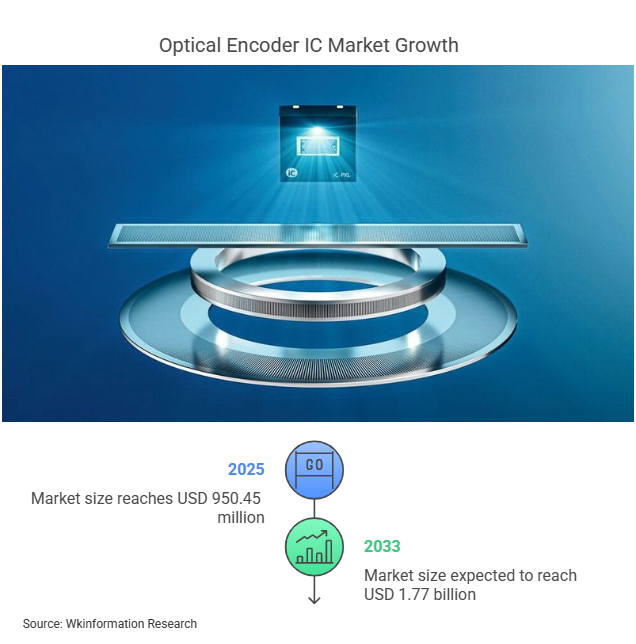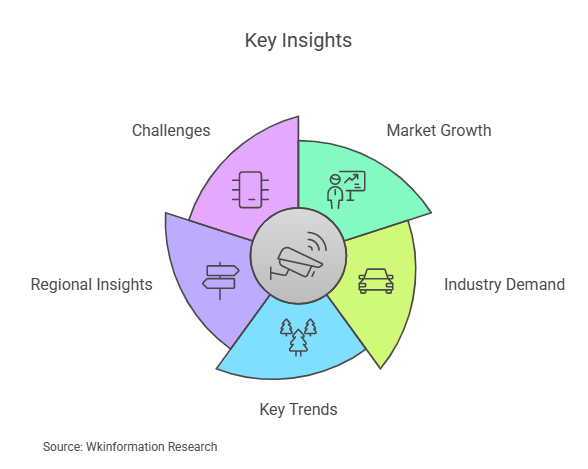
The global optical encoder market is witnessing remarkable growth, driven by advancements in automation and electronics. The market size will reach USD 950.45 million in 2025 and is expected to reach USD 1.77 billion by 2033, with a CAGR of 8.1% between 2025 and 2033. Optical encoder ICs play a pivotal role in enhancing precision and reliability. They enable smart manufacturing in industrial automation, improve user experience in consumer devices, and support critical applications in aerospace and healthcare. These trends highlight the growing significance of optical encoders in modern technology.
Key Insights
- The global optical encoder ICs market may reach $1.77 billion by 2033. This growth is due to demand in industries like cars and healthcare.
- Optical encoders improve accuracy and dependability, making them important for smart factories and new technologies.
- Key trends include better high-resolution encoders, adding wireless features, and focusing on eco-friendly solutions.
- North America leads the market. Big growth is also expected in Asia-Pacific because of fast industrial growth.
- Problems like high prices and tricky designs need solving for more people to use optical encoder ICs in growing markets.

Market Size and Trends

Current Market Valuation
The global optical encoder ICs market was valued at approximately $950.45 million in 2025. This valuation highlights the increasing demand for optical encoder ICs across various industries. The market size reflects the growing adoption of these components in applications such as industrial automation, automotive systems, and consumer electronics. As industries continue to prioritize precision and efficiency, the optical encoder market is expected to maintain its upward trajectory.
Projected Growth and CAGR
The optical encoder ICs market is forecast to grow at a compound annual growth rate (CAGR) of 8.1% from 2025 to 2033. By 2033, the market is projected to reach a valuation of $1.77 billion. These growth trends underscore the increasing importance of optical encoder ICs in driving technological advancements and meeting the demands of modern industries.
Key Trends Shaping the Market
Several key trends are shaping the dynamics of the global optical encoder market:
- Increasing adoption of high-resolution optical encoders to enhance precision.
- Integration of wireless communication interfaces for improved connectivity.
- Development of multi-functional encoder ICs to cater to diverse applications.
- Rapid growth driven by demand from end-users in sectors such as healthcare and automotive.
- Technological innovations leading to improved product performance.
- Rising consumer awareness and preference for environmentally friendly solutions.
The optical encoder ICs market is evolving rapidly, driven by these trends and the growing need for advanced sensing technologies. These dynamics present significant market opportunities for stakeholders aiming to capitalize on the expanding demand for optical encoder ICs.
Market Segmentation
By Type
Incremental Optical Encoder ICs
Incremental optical encoder ICs are widely used for applications requiring relative position changes. These encoders generate output signals corresponding to motion, making them ideal for speed and direction monitoring. Industries such as automotive and industrial automation rely on incremental encoders for their cost-effectiveness and simplicity. Their ability to provide continuous feedback ensures smooth operation in dynamic environments.
Absolute Optical Encoder ICs
Absolute optical encoder ICs deliver unique position values for every location, ensuring high precision and reliability. These encoders are essential for applications where exact positioning is critical, such as robotics and medical imaging. Unlike incremental encoders, absolute encoders retain positional data even after power loss, making them indispensable for safety-critical systems.
By Application
Industrial Automation
Optical encoder ICs play a pivotal role in industrial automation by providing precise position and speed feedback. They are integral to robotics, conveyor systems, and CNC machines, enabling smart manufacturing practices. Their adoption enhances productivity and operational efficiency.
Consumer Electronics
In consumer electronics, optical encoder ICs improve user experience by delivering accurate positional feedback. Devices like gaming consoles, cameras, and smartphones benefit from these components, ensuring seamless functionality and enhanced performance.
Automotive
The automotive sector leverages optical encoder ICs for steering, motor control, and braking systems. These encoders are particularly vital in electric and autonomous vehicles, where precision and reliability are paramount. Their integration supports advanced driver-assistance systems (ADAS) and enhances vehicle safety.
Healthcare
Healthcare applications demand high precision, and optical encoder ICs meet this requirement effectively. They are used in diagnostic equipment, medical imaging systems, and robotic surgical tools, ensuring accurate positioning and motion control.
By Region
North America
North America dominates the optical encoder ICs market. The region’s leadership stems from its advanced technology infrastructure, significant investments, and a strong consumer base. Industrial automation and robotics drive demand, particularly in manufacturing and assembly lines.
Europe
Europe exhibits robust growth in the optical encoder market, driven by its automotive and industrial sectors. The region’s focus on technological advancements and sustainability has spurred the adoption of optical encoder ICs in electric vehicles and renewable energy systems.
Asia-Pacific
Asia-Pacific represents the fastest-growing region in the global optical encoder market. Rapid industrialization, urbanization, and the expansion of manufacturing and electronics sectors contribute to this growth. Countries like China and Japan lead in automotive and consumer electronics production, further boosting demand.
Rest of the World
Emerging markets in the rest of the world offer untapped potential for the optical encoder ICs market. However, challenges such as limited technological infrastructure and market penetration hinder growth. Despite these obstacles, increasing investments in automation and healthcare present opportunities for expansion.
Growth Drivers
Industrial Automation and Smart Manufacturing
Industrial automation has emerged as a key driver for the optical encoder market. These components play a critical role in providing precise position and speed feedback in machinery and robotics. This functionality enhances motion control, which is essential for automated systems.
The global optical encoder market benefits significantly from the adoption of smart manufacturing practices. Industries are increasingly integrating advanced technologies to streamline operations and reduce downtime. Optical encoder ICs enable these advancements by delivering reliable performance in dynamic environments. As industrial automation continues to expand, the optical encoder ICs market is poised for sustained growth opportunities.
Expansion of Electric Vehicles (EVs)
The rapid expansion of electric vehicles has created substantial growth opportunities for the optical encoder ICs market. These components are integral to EV systems, supporting motor control, steering, and braking mechanisms.
Optical encoder ICs contribute to the precision and reliability required in electric and autonomous vehicles. Their integration enhances vehicle safety and supports advanced driver-assistance systems. As the EV market continues to grow, the optical encoder market will experience parallel growth, driven by the need for advanced sensing technologies.
Technological Advancements in Optical Sensing
Technological advancements in optical sensing have significantly influenced the global optical encoder market. The development of high-resolution optical encoders has improved the accuracy and reliability of position feedback mechanisms. Innovations in sensor design, materials, and processing algorithms have further enhanced product performance.
The integration of advanced communication interfaces has expanded the application scope of optical encoder ICs. These advancements align with the increasing adoption of automation technologies and the rising demand for precise sensing solutions. Growth opportunities also stem from the evolution of autonomous driving technologies, where optical encoders play a pivotal role. These trends indicate a promising forecast for the optical encoder ICs market, driven by continuous innovation.
Rising Demand in Consumer Electronics
The consumer electronics sector has emerged as a significant driver of the optical encoder ICs market. Devices such as gaming consoles, smartphones, and wearables rely heavily on these components to deliver precise positional feedback and enhance user interfaces. As the demand for smart and connected devices continues to rise, the optical encoder market is poised for sustained growth. This trend reflects the increasing reliance on sophisticated control systems and intuitive user experiences in modern electronics.
The global optical encoder market benefits from continuous innovation in consumer electronics. Manufacturers are developing advanced optical encoder ICs to meet the evolving needs of this dynamic sector. These innovations include higher resolution encoders, improved durability, and integration with wireless communication technologies. Such advancements enable seamless functionality in devices, ensuring they remain competitive in a rapidly changing market.
The market size of optical encoder ICs is projected to expand significantly due to the growing adoption of smart devices. Analysts forecast a compound annual growth rate (CAGR) of 8.1% for the optical encoder ICs market from 2025 to 2033. This growth underscores the critical role of these components in shaping the future of consumer electronics. As new applications emerge, the demand for optical encoder ICs will likely accelerate further.
Challenges and Limitations
Design and Manufacturing Complexity
The optical encoder ICs market faces significant challenges in design and manufacturing. These components require intricate engineering to achieve the precision demanded by modern applications. Manufacturers must address issues such as limited accuracy in certain encoder types and the need for regular maintenance. Intense competition within the global optical encoder market further complicates matters, as companies often engage in price wars that reduce profit margins. Balancing cost reductions with quality and reliability remains a critical hurdle. Additionally, developing advanced technologies necessitates substantial investments in research and development. Regulatory compliance adds another layer of complexity, consuming resources and time. The reliance on specific industries, such as automotive and consumer electronics, exposes the market to economic fluctuations and shifts in consumer preferences, further complicating production strategies.
High Costs of Advanced Optical Encoder ICs
Advanced optical encoder ICs are costly due to their intricate design and precision manufacturing processes. These expenses make it challenging for smaller businesses to adopt such technologies, particularly in cost-sensitive industries. The high cost limits market adoption in regions where affordability is a primary concern. For instance, industries like consumer electronics and automation often struggle to justify the expenditure on these components, despite their benefits. This financial barrier slows the growth of the optical encoder ICs market, especially in emerging economies. Companies must innovate to reduce production costs while maintaining the performance and reliability of their products to expand their market size and reach.
Safety and Reliability Concerns in Critical Applications
Safety and reliability remain paramount in critical applications such as healthcare, aerospace, and automotive. Optical encoder ICs must deliver consistent performance under varying conditions to ensure operational safety. Failures in these systems can lead to severe consequences, including equipment malfunctions or accidents. For example, in electric vehicles, encoder inaccuracies could compromise motor control or braking systems. Manufacturers must prioritize rigorous testing and quality assurance to address these concerns. However, achieving this level of reliability often increases production costs and development time, presenting a significant challenge for the optical encoder market.
Regional Analysis

North America
Market size and growth rate
North America remains a significant player in the optical encoder ICs market. This steady growth reflects the region’s robust technological infrastructure and increasing adoption of advanced sensing solutions.
Key industries driving demand
Several industries in North America are driving the demand for optical encoder ICs:
- Automotive: The advanced automotive sector relies on these components for precision in electric and autonomous vehicles.
- Healthcare: Medical imaging and diagnostic equipment benefit from the high accuracy of optical encoders.
- Consumer Goods: Devices like gaming consoles and smart appliances integrate these technologies for enhanced functionality.
- Automation: High investments in research and development and the adoption of automation technologies across various sectors further fuel demand.
The region’s focus on innovation and automation ensures sustained growth in the optical encoder ICs market.
Europe
Adoption in automotive and industrial sectors
Europe’s automotive sector has embraced optical encoder ICs due to the rising demand for high-precision components. The growth of electric vehicles and autonomous driving technologies has further accelerated adoption. Advanced driver-assistance systems (ADAS) rely heavily on these encoders, which meet stringent safety standards. The industrial sector also benefits from the integration of optical encoders, enhancing operational efficiency and precision in manufacturing processes.
Technological advancements
Technological advancements in Europe contribute significantly to the growth of the optical encoder ICs market:
- Sustainability Focus: Stringent regulatory standards and a focus on renewable energy drive demand for optical encoder technologies.
- IoT and AI Integration: The integration of optical encoders with IoT and AI technologies creates new opportunities for real-time monitoring and control.
- Smart Manufacturing: These advancements enhance operational efficiency, aligning with Europe’s commitment to innovation and sustainability.
Europe’s emphasis on cutting-edge technologies ensures its position as a key market for optical encoder ICs.
Asia-Pacific
Rapid industrialization and urbanization
Asia-Pacific experiences rapid industrialization and urbanization, significantly boosting the optical encoder ICs market. Countries like China and India lead this growth due to their expanding manufacturing capabilities and rising middle-class populations. Increased investments in technology and infrastructure further enhance market opportunities, making the region a hub for innovation and production.
Dominance in manufacturing and electronics
Asia-Pacific dominates the manufacturing and electronics sectors for optical encoder ICs. Robust manufacturing hubs in China, Japan, and South Korea drive this dominance. The swift integration of automation technologies in these countries ensures the region’s leadership in the global market. This dominance reflects the region’s ability to meet the growing demand for advanced sensing solutions across various industries.
Rest of the World
Emerging Markets and Untapped Potential
The optical encoder ICs market in the Rest of the World, encompassing regions like Latin America, the Middle East, and Africa, exhibits moderate growth potential. Industrialization and the adoption of advanced technologies across various sectors drive this expansion.
These regions benefit from rapid infrastructure development and increasing industrial activities. Rising consumer demand for optical encoder IC products further contributes to market growth. For instance, industries in Latin America are increasingly adopting automation technologies to enhance productivity. Meanwhile, the Middle East and Africa are leveraging optical encoder ICs in sectors such as healthcare and manufacturing to meet the growing need for precision and efficiency. These trends highlight the untapped potential of these markets, presenting opportunities for stakeholders to expand their presence.
Challenges in Market Penetration
Despite the promising growth, penetrating the optical encoder ICs market in these regions poses significant challenges. The high cost of advanced optical encoder ICs often deters potential buyers, particularly in cost-sensitive markets. Many businesses in these regions struggle to justify the investment required for these components, even when they offer long-term benefits.
Additionally, certain types of encoders face limitations in accuracy, which can impact their reliability in critical applications. Regular maintenance requirements further add to the complexity and cost for users, creating barriers to widespread adoption. These challenges necessitate innovative solutions from manufacturers to reduce costs while maintaining product quality. Addressing these issues will be crucial for companies aiming to establish a foothold in these emerging markets.
Major Players in the Optical Encoder ICs Market
The optical encoder ICs market is highly competitive, with several key players driving innovation and market growth. These companies focus on developing advanced products and expanding their global presence to maintain a competitive edge.
Leading Companies
- Broadcom Inc.
- Renesas Electronics Corporation
- AMS AG
- TE Connectivity
- Honeywell International Inc.
- Omron Corporation
- Rockwell Automation Inc.
- Sensata Technologies
- Dynapar Corporation
- Bourns Inc.
These key players contribute significantly to the global optical encoder market through their technological expertise and market strategies.
Innovations and Contributions
Recent Product Launches
Major players in the optical encoder ICs market continue to introduce innovative products to meet evolving industry demands. For instance, Omron Corporation launched the E6B2-CWZ6C encoder in June 2023. This product features an IP68 rating and operates efficiently in extreme temperatures ranging from -40°C to 85°C. Such advancements highlight the industry’s commitment to enhancing product durability and performance.
Strategic Partnerships and Acquisitions
Key players in the optical encoder ICs market actively pursue strategic partnerships and acquisitions to strengthen their market position. Companies collaborate with technology providers and end-users to expand their market reach. Mergers and acquisitions enable them to enhance product portfolios and enter new geographical markets. Acquiring smaller firms with complementary technologies is a common strategy to drive innovation and maintain a competitive edge.
These efforts by key players ensure the optical encoder ICs market remains dynamic and responsive to industry needs. The report underscores the importance of these strategies in shaping the future of the global optical encoder market.
Overview
The optical encoder ICs market continues to demonstrate robust growth, with a projected CAGR of 8.1% from 2025 to 2033. The market size reflects increasing adoption across industries such as automotive, healthcare, and consumer electronics. Stakeholders can capitalize on opportunities by leveraging automation technologies, integrating IoT and AI, and addressing the rising demand for precise feedback mechanisms. Advancements in miniaturization and AI integration will drive innovation, while emerging applications in aerospace and autonomous vehicles will expand the global optical encoder market. This report underscores the dynamic market outlook and its potential for sustained growth.
| Report Metric | Details |
|---|---|
| Report Name | Global Optical Encoder ICs Market Report |
| Base Year | 2024 |
| Segment by Type | · Incremental Optical Encoder ICs
· Absolute Optical Encoder ICs |
| Segment by Application | · Industrial Automation
· Consumer Electronics · Automotive · Healthcare |
| Geographies Covered | · North America (United States, Canada)
· Europe (Germany, France, UK, Italy, Russia) · Asia-Pacific (China, Japan, South Korea, Taiwan) · Southeast Asia (India) · Latin America (Mexico, Brazil) |
| Forecast units | USD million in value |
| Report coverage | Revenue and volume forecast, company share, competitive landscape, growth factors and trends |
FAQ
What are optical encoder ICs, and why are they important?
Optical encoder ICs are integrated circuits that convert motion into digital signals. They are essential for applications requiring precise position or speed feedback, such as robotics, automotive systems, and medical devices. Their accuracy and reliability make them indispensable in modern technology.
Which industries benefit the most from optical encoder ICs?
Industries like automotive, healthcare, consumer electronics, and industrial automation benefit significantly. These sectors rely on optical encoder ICs for precision, efficiency, and enhanced performance in applications like electric vehicles, diagnostic equipment, and smart manufacturing systems.
How do incremental and absolute optical encoders differ?
Incremental encoders measure relative position changes, while absolute encoders provide unique position values for every location. Absolute encoders retain positional data after power loss, making them ideal for safety-critical applications. Incremental encoders are cost-effective and suitable for speed and direction monitoring.
What challenges does the optical encoder ICs market face?
The market faces challenges like high production costs, design complexity, and safety concerns in critical applications. Manufacturers must balance affordability with quality and reliability to address these issues and expand market adoption.
What is driving the growth of the optical encoder ICs market?
The market grows due to increasing demand for automation, electric vehicles, and advanced sensing technologies. Rising adoption in consumer electronics and healthcare also contributes to this growth. Technological advancements further enhance the performance and application scope of optical encoder ICs.
Global Optical Encoder ICs Market Report – Table of Contents
1 Market Study Overview
2 Basic Product Information
3 Market Analysis
4 Optical Encoder ICs Related Market Analysis
5 Global Trend Summary
6 Competition by Manufacturer
7 Analysis of Key Players
8 Global Optical Encoder ICs Revenue, Sales Categorized by Regions
9 North America Optical Encoder ICs Market Size Categorized by Countries
10 Europe Optical Encoder ICs Market Size Categorized by Countries
11 Asia-pacific Optical Encoder ICs Market Size Categorized by Countries
12 South America Optical Encoder ICs Market Size Categorized by Countries
13 Middle East and Africa Optical Encoder ICs Market Size Categorized by Countries
14 Global Optical Encoder ICs Industry Segment Analysis
15 Global Optical Encoder ICs Market Forecast
16 Research Findings and Conclusion
17 Appendix



